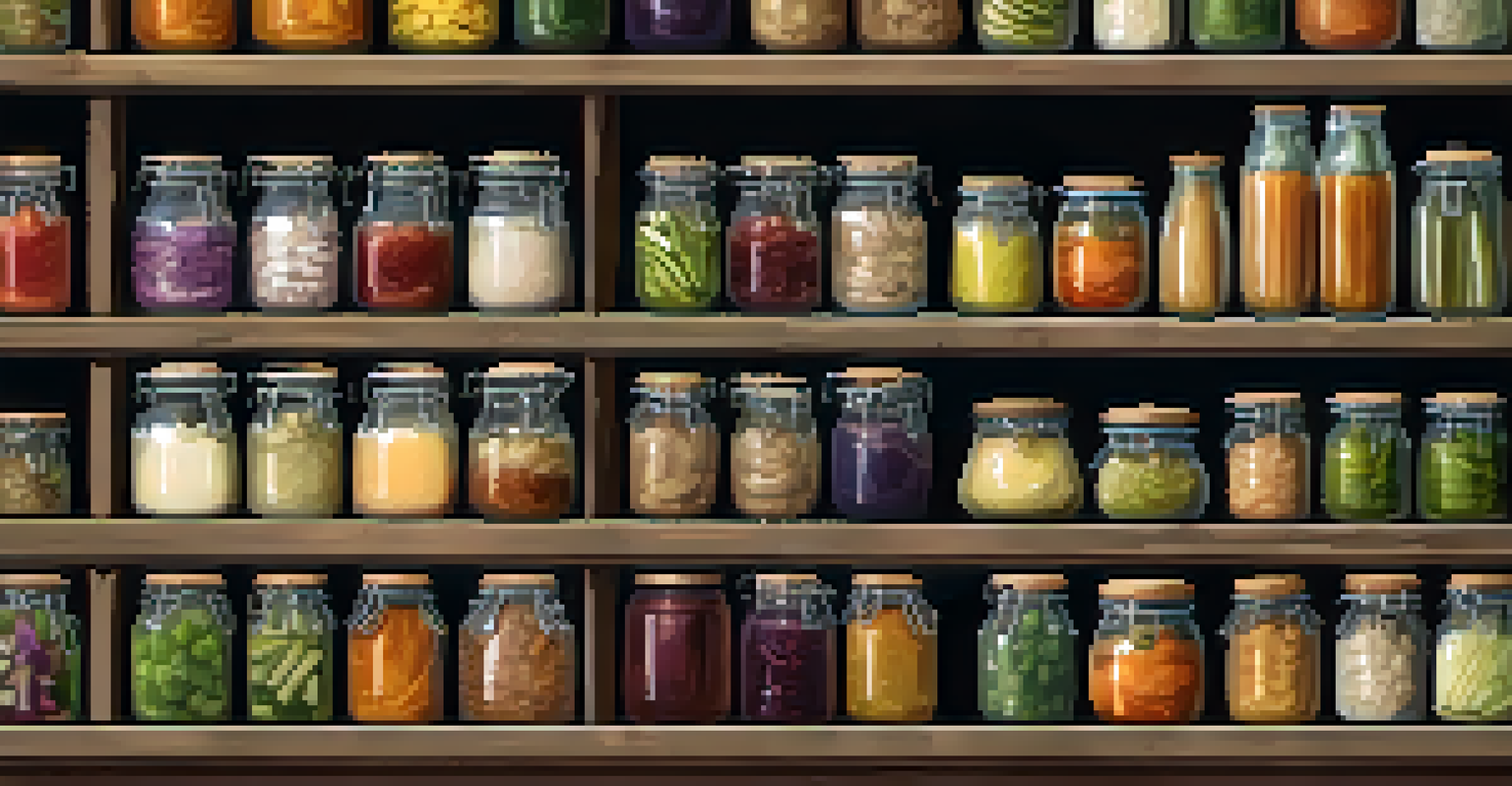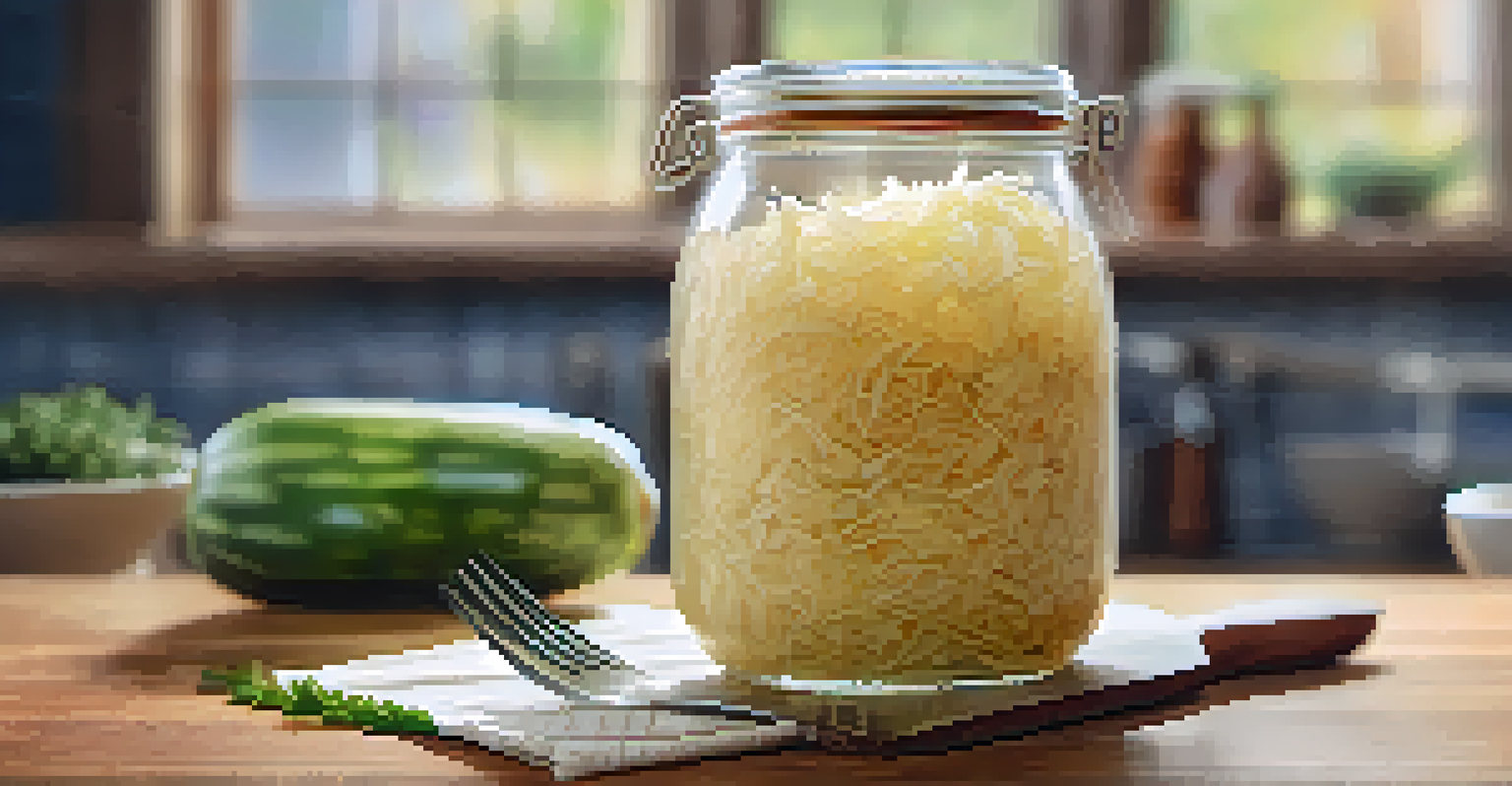Tips for Fermenting: Creating Flavorful Vegan Foods at Home

Understanding the Basics of Fermentation
Fermentation is a natural process where microorganisms like bacteria and yeast break down sugars and starches. This not only preserves food but also enhances its flavor and nutritional profile. For instance, think of how sourdough bread rises and develops its tangy taste through fermentation—it's all about those tiny critters doing their magic!
Fermentation is the ultimate form of recycling. It transforms waste into something nutritious and delicious.
In the vegan world, fermentation is a fantastic way to create rich flavors and textures without animal products. Foods like kimchi, sauerkraut, or even miso can easily elevate your meals. Plus, fermented foods are known for their probiotic benefits, supporting gut health and digestion.
Before diving into your fermentation journey, it's crucial to understand the basic principles and safety measures. Cleanliness is key, as unwanted bacteria can spoil your batch. Always use sterilized jars and utensils to ensure a successful fermentation process.
Choosing the Right Ingredients for Fermentation
Ingredients play a vital role in successful fermentation. Start with fresh, organic vegetables, fruits, or grains—these will not only taste better but also provide the necessary nutrients for the fermentation process. For example, cabbage is the star of sauerkraut, while cucumbers shine in pickle recipes.

When selecting your ingredients, consider the flavors and textures you want to achieve. For instance, adding spices like garlic, ginger, or chili can create a delightful kick in your ferments. These ingredients not only enhance taste but also contribute to the diversity of probiotics.
Fermentation Basics Explained Simply
Fermentation is a natural process where microorganisms break down sugars to enhance food flavor and nutritional value.
Don’t forget about salt! It helps to draw out moisture from vegetables, creating an environment where beneficial bacteria can thrive. Using the right amount of salt can mean the difference between a tasty batch and a less savory one, so follow recipes carefully.
Essential Equipment for Home Fermentation
You don't need a fancy setup to start fermenting at home; basic kitchen tools will do just fine. A clean glass jar or container with an airtight lid is typically all you need. For example, a simple mason jar works wonders for many fermentation projects, from pickles to kimchi!
The best part about fermentation is that there are no rules. You can create your own flavors and experiment with combinations.
You may also want to invest in fermentation weights. These help keep your ingredients submerged in the brine, preventing exposure to air, which can lead to spoilage. If you don't have weights, you can use clean rocks or even a smaller jar filled with water as a makeshift solution.
Lastly, consider investing in a pH meter or strips. While not essential, monitoring pH levels can help you ensure your ferment is safe and within the ideal range. Keeping track of pH can also give you insight into the fermentation process and how flavors are developing.
The Importance of Temperature and Environment
Fermentation is highly influenced by temperature, which affects the activity level of bacteria and yeast. Generally, a warm environment (around 65-75°F) is ideal for most ferments. For example, if your kitchen is too cold, your fermentation may slow down, resulting in less flavor development.
It's also crucial to keep your ferment away from direct sunlight. A dark, cool spot in your kitchen, like a cupboard, is perfect for allowing the fermentation process to unfold without interference. Just think of it like a cozy retreat for your ingredients to transform!
Key Ingredients for Successful Ferments
Using fresh, organic ingredients and the right amount of salt is crucial for creating delicious and safe fermented foods.
Monitoring the environment is essential, particularly in warmer months when temperatures can fluctuate. If it gets too hot, your ferment may spoil. On the flip side, if it’s too cold, it might not ferment at all. Finding that sweet spot will ensure your efforts yield delicious results.
Timing: How Long to Ferment Your Foods
Timing can be tricky when fermenting, as each type of food has its ideal fermentation period. For example, sauerkraut typically ferments for about 1-4 weeks, while kimchi can take anywhere from a few days to several weeks, depending on your taste preference. It's all about finding that perfect balance between flavor and texture!
Tasting regularly during the fermentation process is a great way to gauge when your ferment is ready. This allows you to stop the process at your desired flavor profile. Just remember that flavors will continue to develop even after fermentation stops, especially if stored in the fridge.
Keep in mind that environmental factors such as temperature and humidity can affect timing. Don’t be afraid to adjust your fermentation time based on your observations. Patience is key; letting your ferments sit a little longer can lead to more complex and exciting flavors!
Storing Your Fermented Foods Properly
Once your fermentation is complete, proper storage is essential to maintain flavor and prevent spoilage. Most fermented foods can be transferred to the refrigerator, which slows down the fermentation process. This means you can enjoy your creation for weeks or even months!
Glass jars with airtight seals are ideal for storage, as they help preserve the freshness and flavor. Just make sure to keep your ferments submerged in brine to avoid exposure to air. If you notice any mold on the surface, don’t panic—just skim it off, and your food should still be safe to eat.
Storing Fermented Foods Safely
Proper storage in airtight jars helps maintain flavor and prolong the freshness of your fermented creations.
Labeling your jars with the date and type of ferment can help you keep track of freshness. This way, you’ll know when to enjoy your delicious creations before they lose their zing. Plus, it makes your fridge look organized and ready for tasty meals!
Experimenting with Flavors and Combinations
One of the best parts about fermenting at home is the opportunity to experiment with flavors! Don’t be afraid to mix and match different vegetables, spices, or even fruits to create unique ferments. For example, try adding carrots to your traditional cucumber pickles for a sweet twist!
You can also explore different fermentation methods, such as wild fermentation using naturally occurring bacteria from the environment. This approach can lead to exciting and unexpected flavors, adding a bit of spontaneity to your culinary adventures. Just remember to keep an eye on the process, as results can vary.

Keep a journal of your fermentation experiments—this way, you can track what works and what doesn’t. Over time, you’ll build a repertoire of delicious recipes that reflect your personal taste. After all, the joy of fermentation is not just in the food, but in the creative process!